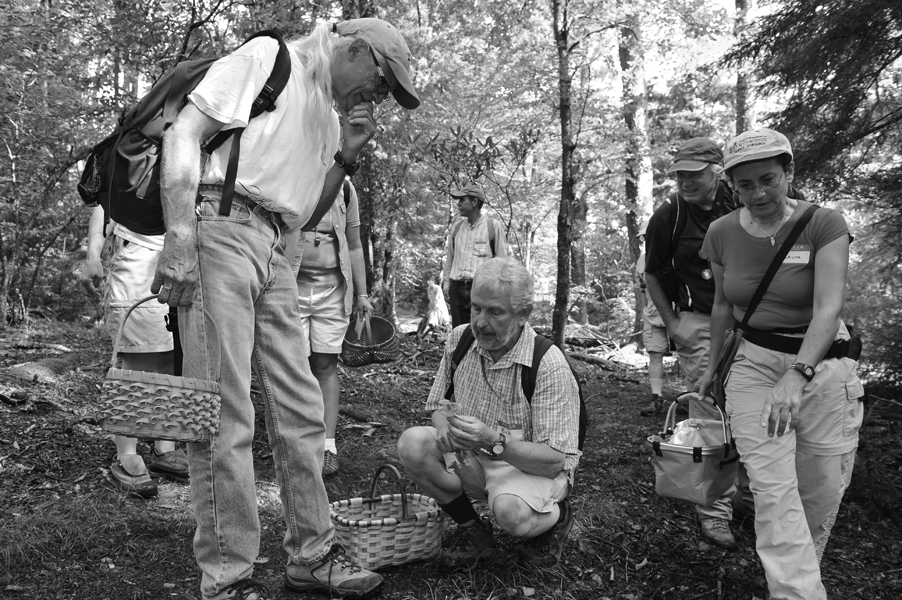"Almost Mushroom Heaven"
Finding Fungi in the Mountain State
Text and photographs by Carl E. Feather

Field biologist Bill Roody, at center, leads a group of hikers on a mushroom hunt at Blackwater Falls State Park.
Bill Roody paused in the middle of a hemlock stand at Blackwater Falls State Park and drew the hikers’ attention to the tidy forest floor.
“You have fungi to thank for that,” Bill told the group of mushroom enthusiasts. “All that stuff that falls off the trees year after year would pile up and pile up every year. You can thank fungi for giving us beautiful open woods.”
Bill, a resident of Barbour County, is a field biologist with the West Virginia Division of Natural Resources and an expert in the field of mycology - the study of mushrooms and other fungi. He literally wrote the book on the subject when it comes to the Mountain State’s mushrooms. Mushrooms of West Virginia and the Central Appalachians is a hefty but accessible volume that Bill wrote and illustrated with his stunning photographs of nearly 400 species. Bill has written or co-authored several other books on the subject of fungi, as well.
He’s also responsible for discovering at least six new species of mushrooms, including one named after him, Boletus roody, first identified from Teter Creek Lake in Barbour County.
Bill’s interest in mycology goes along with his passion for the outdoors. “I’m just a natural history buff,” the upstate New York native says. “I look into anything. When I got into fungi, they just captivated me. [The study of fungus] was more demanding, and all my other interests took a back seat.”
He came to West Virginia three decades ago to work for the state on a Peregrine Falcon project. But as Bill spent time in the forest studying the falcon, he also took notice of the variety of mushrooms.
“The interest for me, personally, was, ‘What are these things?’” he recalls. “They were so beautiful, and [so] I started photographing them. I can’t resist certain things [in nature] that are really attractive.”
A part of that interest is the culinary use of mushrooms, but even more so is the mushroom as a photogenic subject. “Some mushrooms are extraordinarily beautiful when they are fresh,” he says, a statement confirmed by the images in his book.
Bill says fungi receive little attention in naturalist circles, despite their ubiquity and role in keeping forests tidy and productive. This relative obscurity even extends to West Virginia, which, with the exception of some damp areas of the Smoky Mountains, offers the best mushroom hunting in the Eastern United States.
“It’s almost mushroom heaven,” Bill Roody says.
“It’s one of the best places in the country, no question about that,” says Gary Lincoff, an instructor with the New York Botanical Garden and author of the National Audubon Society Field Guide to North American Mushrooms and two other books on the topic.
Lincoff says West Virginia, with its variety of elevations and climates, provides a vast range of mushrooms endemic to both northern and southern locations. The diverse mixed hardwood and conifer forests and the extensive rainfall provide the perfect habitat for these efficient recycling machines. Nearly 1,700 species of mushrooms and other large fungi have been recorded for the state.
Despite the abundance of fungi species, most biologists are much more comfortable studying wildflowers, amphibians, or insects of the Alleghenies than they are mushrooms.
“Mushrooms are really no more difficult to identify than plants,” Lincoff insists. “But even botanists don’t want to try to identify them.”
Surprisingly, even native Mountaineers, who often look upon their forests as both larder and pharmacy, are reluctant to hunt the wild mushroom.
You can read the rest of this article in this issue of Goldenseal, available in bookstores, libraries or direct from Goldenseal.